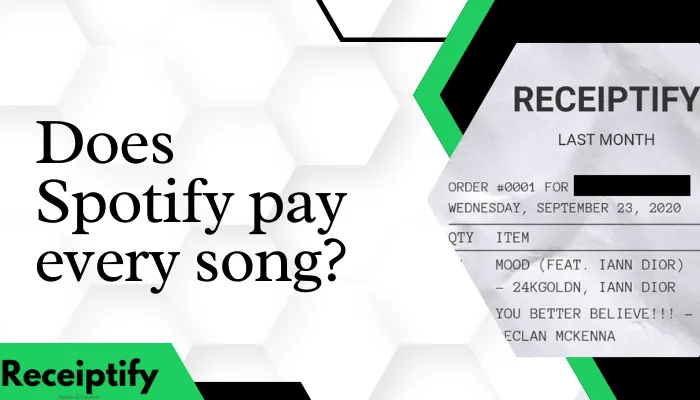Music streaming services have completely transformed the way in which we consume music. However, for those who make the music one question still remains – how does Spotify pay them and do they get paid every time their song is played? This article will delve into Spotify’s payment model, look at how revenue is generated, and explain what royalties are within the music industry.
Yes, in short, Spotify does pay artists (or rights holders) when their song has been streamed on the platform. However, this isn’t done through a direct 1-to-1 payment system and there is more to it than meets the eye; this article will explore these complexities along with Does Spotify Pay Every Song?

Understanding Does Spotify Pay Every Song?
Spotify works using a freemium model, meaning that both free and paid subscription tiers are offered. Free users will listen to music with advertisements between songs. Premium subscribers pay each month for ad-free listening, higher quality audio as well as being able to play music on demand.
How does Spotify Generate Revenue?
Subscription Fees: The main source of income for Spotify comes from subscriptions being paid. Each month premium subscribers give them a set amount which then goes into paying artists or rights holders from this pool created.
Advertising Revenue: If more people listen via the free tier then there are more chances of ads being heard thus generating more advertising revenue for spotify
Genre Neutrality: Genre will not affect how much an artist earns so long as their song is streamed.
Disadvantages:
- Unequal Payouts: Because super popular artists have such a huge share of the total streams, they end up getting paid way more than lesser-known artists do.
- Gaming the System: To boost their stream counts and earn more money, some artists (or labels) may resort to tactics such as “playlist stuffing.”
However, it’s important to remember that this is just one piece of the puzzle. There are many other factors which can determine an artist’s pay-per-stream rate on Spotify.
Factors Influencing How Much Artists Get Paid Per Stream
- Stream Location: If a lot of people in countries with higher licensing costs stream your music, then you’ll earn more money per stream.
- Stream Length: Streams shorter than 30 seconds might not qualify for full royalty payouts.
- Free vs. Premium Streams: A premium subscriber listening to your song will generate higher royalties than if it were played on the free tier with ads.
- Splitting the Pie: Depending on agreements made between them, royalties could be divided among multiple different parties including songwriters or producers or labels themselves.
Artists need to understand these factors so that they can set realistic expectations about what they will make from their music being available for streaming online and plan accordingly for their careers in this industry.
This section has only scratched the surface when it comes to understanding how Spotify pays its artists; however, there are still more parts left unsaid! Music distributors and labels play equally important roles in ensuring that every penny earned eventually reaches its rightful owner – let’s dive into those next!
The Intricate Web: Music Labels, Distributors, and Artist Royalties
The path from Spotify revenue to artist pocket isn’t always linear; instead, it often looks more like a web thanks to intermediaries such as music labels and distributors – who may themselves be involved in negotiating deals with streaming platforms.
H3: Explanation of the Relationship Between Spotify, Music Labels, and Distributors
- Music Labels: Also known as record companies or simply “labels,” these businesses act as middlemen between musicians/bands/songwriters on one side and services like Spotify on another. They provide artists with resources such as recording studios (or money to rent them), marketing campaigns (or budget to pay for them), advances against future royalties… the list goes on! In return they take hefty cuts out of any money generated by sales or streams – typically around 70% but this can vary wildly depending on various factors including fame level achieved.
- Distributors: Companies which help get tracks onto streaming platforms like Apple Music & TIDAL; some even specialize solely in distributing content across different DSPs (Digital Service Providers). These entities are responsible for ensuring that songs meet technical requirements set forth by each individual platform before being made available thereon; fees may apply but usually only cover costs incurred during submission process itself rather than ongoing revenue share from each stream played back via said service provider.
Here’s how it works at a high level:
- Artist uploads music to distributor.
- Distributor sends music to Spotify etc..
- People listen & ads run = $ is made.
- Rights holders get paid out (usually labels) based on their agreements with streaming services like Spotify regarding what percentage of total revenue should come their way given number of streams achieved during an accounting period determined by contract terms between parties involved).
- Labels take deductions fee then pay remaining royalties over artist (and potentially songwriters/producers) according their contracts w/ label/distributor combo used for release(s).
How Music Labels Negotiate Deals with Spotify?
The terms of a label’s deal with Spotify can greatly affect how much $ goes into an artist’s pocket, here are some things they might ask for:
- Guaranteed Minimum: Labels may secure this where regardless of whether or not any given track receives massive amounts of streams – an agreed upon minimum sum will be paid out each accounting period (usually quarterly) based on such agreements.
- Royalty Rates: Labels could negotiate higher rates than those offered as standard but there’s no set formula; it really comes down to power dynamics between parties involved at time negotiations take place.
- Ownership and Control: Who keeps master recordings after deal ends? Who controls publishing rights throughout its duration? These questions need answering before deciding who gets what share from royalties generated by said music while under contract.
For independent artists who don’t have a label deal, the process can be simpler. They can work directly with distributors to get their music on Spotify and receive a higher percentage of the royalties (minus the distributor’s fees).
The effect of Label Deals on Artist Royalties
There are two sides to every coin. With reference to artists, this is how it works when they sign up with music labels:
Perks:
- Resources and Support: Labels give money which can be used for various things such as promotion or industry connections among others.
- Negotiation Power: Major record companies may have an upper hand when negotiating better contracts that allow them earn more from streaming services like Spotify.
Drawbacks:
- Reduced Royalties: Artists signed under big record labels tend to receive small percentages as part of their total earnings because there are deductions made for recoupment clauses as well as label fees.
- Creative Control: Album content and marketing strategies could be restricted if one signs up under any given company hence limiting their freedom in expressing themselves through art forms like music creation or visual representations thereof e.t.c.
In the long run, whether or not someone should sign up with a recording company depends entirely upon what they want from life as an entertainer; but mainly success should be based around personal achievements rather than external influences such as fame nor wealth alone.
Conclusion
To sum up Does Spotify pay every song? This part has shown how complicated things get between musicians themselves; producers too; middlemen called publishers including distributors plus streaming platforms like Apple Music which all play different roles within this industry context.
An understanding of these dynamics is very important for any artist who wants to make it big time in showbiz while also ensuring maximum income generation from his/her own songs played back online.
